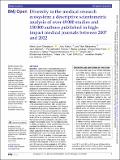Diversity in the medical research ecosystem: a descriptive scientometric analysis of over 49 000 studies and 150 000 authors published in high-impact medical journals between 2007 and 2022
Author(s)
Charpignon, Marie-Laure; Matos, Joao; Nakayama, Luis Filipe; Gallifant, Jack; Alfonso, Pia Gabrielle I; Cobanaj, Marisa; Fiske, Amelia Morel; Gates, Alexander J; Ho, Frances Dominique V; Jain, Urvish; Kashkooli, Mohammad; Link, Naira; McCoy, Liam G; Shaffer, Jonathan; Celi, Leo Anthony; ... Show more Show less
DownloadPublished version (953.3Kb)
Publisher with Creative Commons License
Publisher with Creative Commons License
Creative Commons Attribution
Terms of use
Metadata
Show full item recordAbstract
Objectives Health research that significantly impacts
global clinical practice and policy is often published in
high-impact factor (IF) medical journals. These outlets
play a pivotal role in the worldwide dissemination of novel
medical knowledge. However, researchers identifying as
women and those affiliated with institutions in low- and
middle-income countries (LMICs) have been largely
under-represented in high-IF journals across multiple
fields of medicine. To evaluate disparities in gender and
geographical representation among authors who have
published in any of five top general medical journals, we
conducted scientometric analyses using a large-scale
dataset extracted from the New England Journal of
Medicine, Journal of the American Medical Association,
The BMJ, The Lancet and Nature Medicine.
Methods Author metadata from all articles published
in the selected journals between 2007 and 2022 were
collected using the DimensionsAI platform. The Genderize.
io Application Programming Interface was then used to
infer each author’s likely gender based on their extracted
first name. The World Bank country classification was used
to map countries associated with researcher affiliations
to the LMIC or the high-income country (HIC) category.
We characterised the overall gender and country income
category representation across the five medical journals.
In addition, we computed article-level diversity metrics and
contrasted their distributions across the journals.
Results We studied 151 536 authors across 49 764
articles published in five top medical journals, over a
period spanning 15 years. On average, approximately
one-third (33.1%) of the authors of a given paper were
inferred to be women; this result was consistent across
the journals we studied. Further, 86.6% of the teams
were exclusively composed of HIC authors; in contrast,
only 3.9% were exclusively composed of LMIC authors.
The probability of serving as the first or last author was
significantly higher if the author was inferred to be a
man (18.1% vs 16.8%, p<0.01) or was affiliated with an
institution in a HIC (16.9% vs 15.5%, p<0.01). Our primary
finding reveals that having a diverse team promotes further diversity, within the same dimension (ie, gender or geography) and
across dimensions. Notably, papers with at least one woman among the
authors were more likely to also involve at least two LMIC authors (11.7%
vs 10.4% in baseline, p<0.001; based on inferred gender); conversely,
papers with at least one LMIC author were more likely to also involve at
least two women (49.4% vs 37.6%, p<0.001; based on inferred gender).
Conclusion We provide a scientometric framework to assess authorship
diversity. Our research suggests that the inclusiveness of high-impact
medical journals is limited in terms of both gender and geography. We
advocate for medical journals to adopt policies and practices that promote
greater diversity and collaborative research. In addition, our findings offer
a first step towards understanding the composition of teams conducting
medical research globally and an opportunity for individual authors to
reflect on their own collaborative research practices and possibilities to
cultivate more diverse partnerships in their work.
Date issued
2025-01Department
Institute for Medical Engineering and ScienceJournal
BMJ Open
Publisher
BMJ
Citation
Charpignon M, Matos J, Nakayama LF, et alDiversity in the medical research ecosystem: a descriptive scientometric analysis of over 49 000 studies and 150 000 authors published in high-impact medical journals between 2007 and 2022BMJ Open 2025;15:e086982.
Version: Final published version